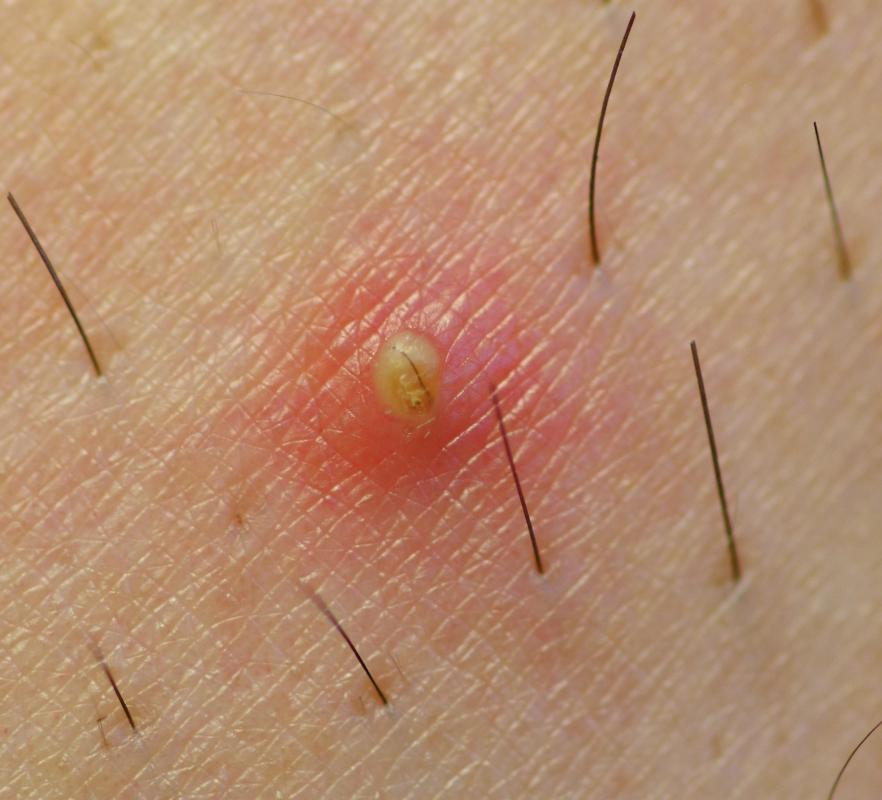At WiseGEEK, we're committed to delivering accurate, trustworthy information. Our expert-authored content is rigorously fact-checked and sourced from credible authorities. Discover how we uphold the highest standards in providing you with reliable knowledge.
What Are the Common Causes of Pus Collection?
Pus collection is caused by a bacterial infection. Although viral infections can cause symptoms similar to those of bacterial infections, they are not responsible for pus formation. Pus collection can commonly result from nail infections, tooth abscesses, and surgical wound infections. The color of pus can vary, but it is generally white, yellow, green or blood tinged. It also has an unpleasant odor, which is due to its high bacterial count.
In addition to pus collection, a local infection may also cause pain, inflammation, and redness. Fever, chills, nausea, vomiting, and body aches might also occur as the result of a pus-producing infection. When the infection causes systemic symptoms, the doctor will often recommend antibiotics. If, however, the infection produces only local symptoms, topical antibiotics may be the treatment of choice.

People who have undergone surgical procedures need to monitor their wound sites for signs and symptoms of pus collection. This may indicate a serious soft tissue infection, and, if not resolved, may cause a serious blood infection, requiring hospitalization and the administration of intravenous antibiotics. When the surgical site produces pain, redness, pus collection, and warmth, it needs to be evaluated to determine the source of the infection. The health care provider might collect a sample of the pus or other drainage to determine which organism is causing the infection. This will also provide valuable information on which antibiotics might prove effective in eradicating the infection.

Eye infections are also common reasons for pus collection. Conjunctivitis or pink eye can cause redness, pain, itching, and the feeling of a foreign body in the eye. Grittiness, or a sand-like feeling, dryness, and draining of pus can also occur. Since pink eye is extremely contagious, it needs to be treated with antibiotic eye drops or oral antibiotics. Hot compresses and over-the-counter pain relievers also help with symptoms, but will do little to eliminate the infection. It is important to wash the hands with hot, soapy water to avoid re-infecting the eye or other parts of the body.
A dentist needs to be consulted when an abscessed tooth is accompanied by pus collection. In addition to causing severe pain, an untreated abscessed tooth can contribute to a throat or ear infection. Although antibiotic treatment is generally effective in relieving a tooth infection, in severe cases, the tooth may need to be extracted to fully eliminate pain and other symptoms.
AS FEATURED ON:
AS FEATURED ON:












Discussion Comments
An abscess on skin actually forms when bacteria gets trapped inside. If there is some type of opening or if an injury is cleaned properly, pus will never form. The bacteria either won't have the opportunity to multiply or the pus that forms will naturally drain out and leave the body.
This is why when there is an internal abscess with pus, doctors will leave an opening for pus to drain after cleaning the abscess.
@donasmrs-- I'm not a doctor or anything, but I think that both bacteria and viruses can lead to a collection of pus. I had tonsillitis a few years ago which was caused by a virus and I did have pus pockets on my tonsils and throat.
The pus might look different though and treatment can be different if it's caused by a virus.
You mentioned cold sores. Cold sores are caused by herpes virus type 1. They do develop into ulcers at one stage and fill with pus. But it's different than a bacterial infection because the ulcer will pop/drain on its own and the cold sore will disappear.
If a pus pocket is caused by bacteria, there is no guarantee that it will go away on its own. Some type of intervention and treatment is usually necessary like antibiotics.
What about cold sores? Cold sores develop infected pus and they are viral in origin. So can we say that pus is always caused by bacteria?
Post your comments